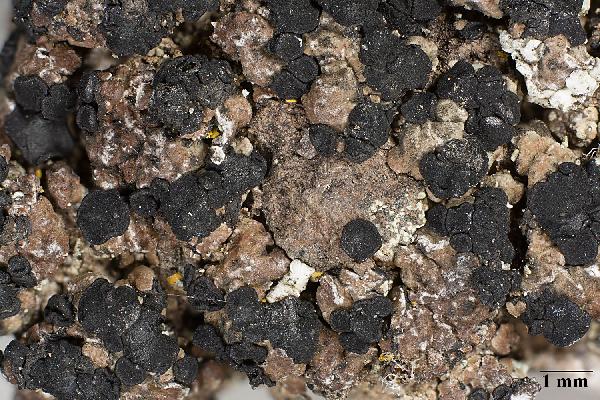Toniniopsis coprodes (Körb.) S. Ekman & Coppins
in Cannon & al., Revisions of British and Irish Lichens 11: 76, 2021. Basionym: Bilimbia coprodes Körb. ex Arnold - Flora, 41: 503, 1858.
Synonyms: Bacidia coprodes (Arnold) Lettau; Bacidia granosa (Tuck.) Zahlbr.; Bacidia salevensis (Müll. Arg.) Zahlbr.; Bacidia subtrachona (Arnold) Lettau; Biatora trachona auct. p.p.; Bilimbia subtrachona Arnold
Distribution: N - Ven (Llop & Ekman 2007), TAA (Nascimbene & al. 2022), Lig (Llop & Ekman 2007, Olech & Czarnota 2009). C - Abr (Nimis & Tretiach 1999, Llop & Ekman 2007, Ekman 2014), Sar. S - Camp, Si (Grillo 1998, Grillo & Caniglia 2004).
Description: Thallus crustose, thin, pale green, grey-green to brownish green, finely warted-areolate or more or less granular, the granules 0.06.0.25 mm in diam, sometimes delimited by a whitish, arachnoid prothallus. Apothecia lecideine, 0.3-1.2 mm across, sessile and constricted at base, orbicular to irregularly lobed, dark brown to black, with an initially flat, then more or less convex, epruinose or (rarely) thinly white-pruinose disc, and a concolorous, often glossy, finally often excluded proper margin. Proper exciple red-brown to greenish black, 47-78 μm wide laterally, of radiating hyphae, containing a red-brown (K+ purplish, N+ orange-red) and a greenish pigment (K+ intensifying green, N+ purple, with deposition of blue crystals); epithecium scarcely differentiated from the hymenium, green (sometimes patchily); hymenium 50-65 μm high, colourless in lower part, merging with the epithecium in upper part, I+ blue; paraphyses 1.5-2.8 μm thick at mid-level, simple or sparingly branched in upper part, rarely anastomosing, the apical cells clavate or some not thickened, 2.5-5 μm wide; hypothecium dark red-brown to greenish black in upper part, almost colourless in lower part. Asci 8-spored, clavate, surrounded by a gelatinous I+ blue coat, with a well-developed I+ blue tholus with a darker blue tube and a well-developed ocular chamber, Bacidia-type. Ascospores 3(-5)-septate, hyaline, straight or slightly curved, bacilliform or narrowly ellipsoid, with blunt ends, 10-20 x 2.5-4.5 μm. Pycnidia semi-immersed in thallus, projecting with the dark brown to black ostiolar region, the wall with a brown (K+ purplish, N+ orange-red) pigment in upper part. Conidia 1-celled, of two types: a) short-bacilliform, narrowly ellipsoid or tear-shaped, straight, 3-10 x 1.5–2.8 μm, or, b) filiform, curved, 6–20 x 0.8-1.0 μm. Photobiont chlorococcoid, the cells 5-12 μm in diam. Spot tests: thallus K-, C-, KC-, P-, UV-. Chemistry: thallus without lichen substances.
Note: on steeply inclined to rain-sheltered faces of calciferous or base-rich siliceous rocks, exceptionally on bark in deep crevices at the base of trunks. The species was frequently identified as Bacidia trachona, but according to Lop & Ekman (2004) the true B. trachona does not belong to Bacidia and has an oceanic distribution in Europe from Portugal to Scandinavia, whereas Mediterranean samples attributed to this taxon belong to T. coprodes. The record from Venezia Giulia in Nimis (1993: 114) has been excluded, being from Slovenia; the record from Friuli in Llop & Ekman (2007) refers to Bacidia notarisiana (see Ekman 2014).
Growth form: Crustose
Substrata: rocks
Photobiont: green algae other than Trentepohlia
Reproductive strategy: mainly sexual
In underhangs rarely wetted by rain
Commonnes-rarity: (info)
Alpine belt: absent
Subalpine belt: absent
Oromediterranean belt: absent
Montane belt: extremely rare
Submediterranean belt: extremely rare
Padanian area: absent
Humid submediterranean belt: extremely rare
Humid mediterranean belt: very rare
Dry mediterranean belt: absent

Predictive model
Herbarium samples

Ulrich Kirschbaum CC BY-SA 4.0 - Source: https://www.thm.de/lse/ulrich-kirschbaum/flechtenbilder
E; Canary Islands; La Gomera-NW; s of Vallehermoso: Camino Forestal de la Meseta. On volcanic rocks
Growth form: Crustose
Substrata: rocks
Photobiont: green algae other than Trentepohlia
Reproductive strategy: mainly sexual
In underhangs rarely wetted by rain
Commonnes-rarity: (info)
Alpine belt: absent
Subalpine belt: absent
Oromediterranean belt: absent
Montane belt: extremely rare
Submediterranean belt: extremely rare
Padanian area: absent
Humid submediterranean belt: extremely rare
Humid mediterranean belt: very rare
Dry mediterranean belt: absent

Predictive model
| Herbarium samples |

 INDEX FUNGORUM
INDEX FUNGORUM
 GBIF
GBIF
 DOLICHENS
DOLICHENS



